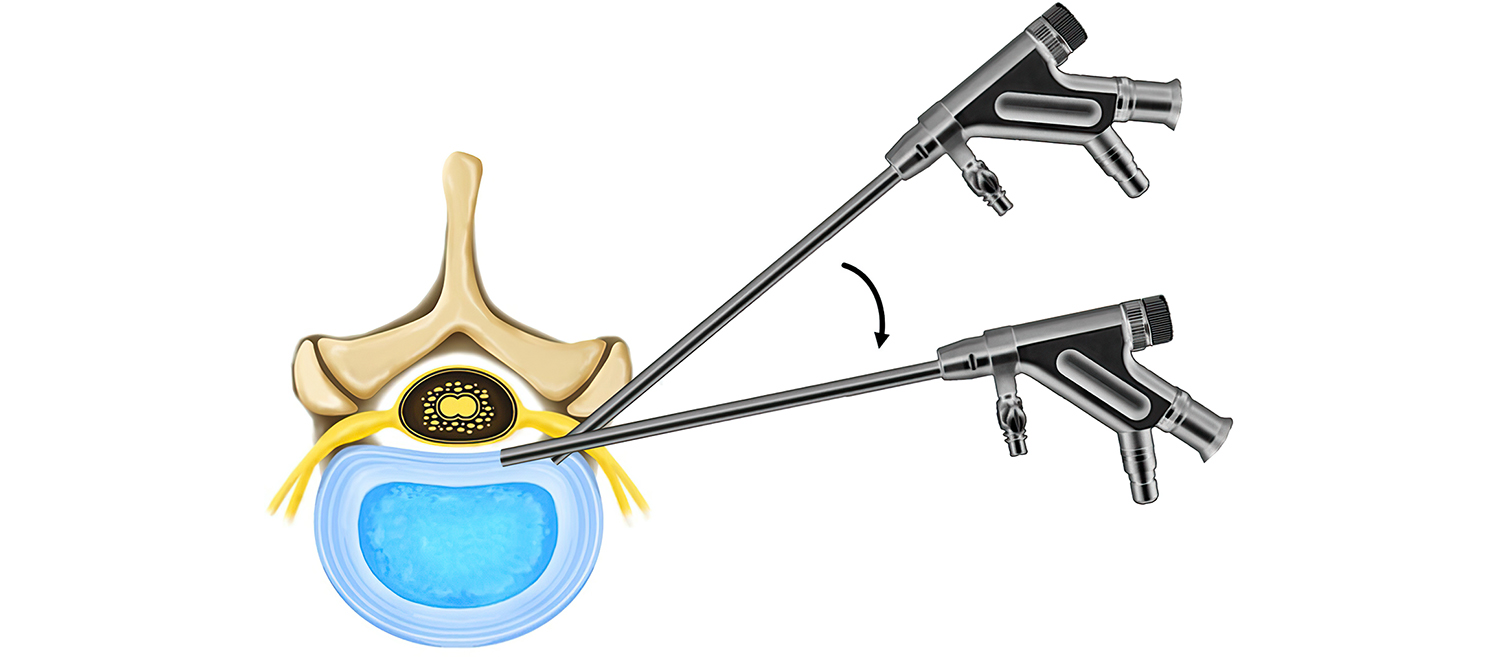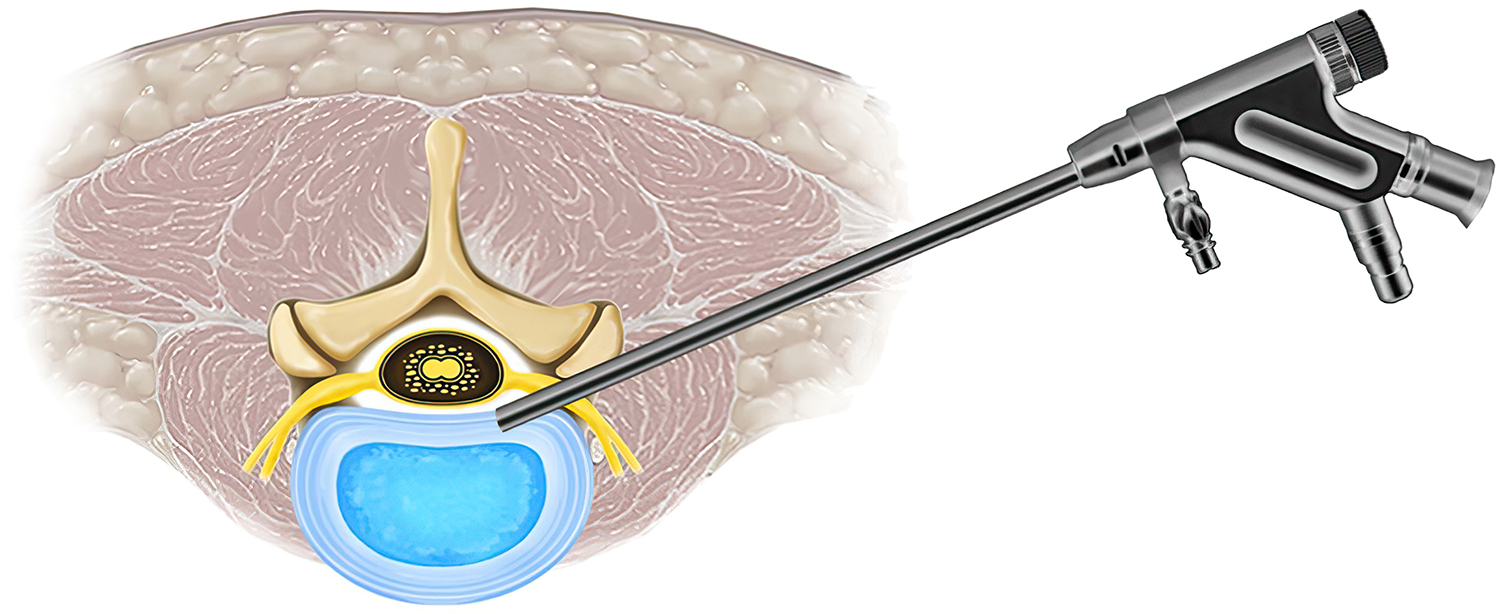ENDOSCOPIC DISCECTOMY

Endoscopic discectomy, a common type of endoscopic spinal surgery, is a minimally invasive surgical procedure used to remove herniated disc material that is causing pain in the lower back and legs (lumbar), mid back (thoracic), or neck and arms (cervical).
Endoscopic discectomy is the least invasive and most effective surgical technique for treating spinal disc herniation patients. With endoscopic spine surgery, surgeons do not need to remove bones and muscles in order to remove herniated discs. Surgeons can see the spine with a camera, smaller than a smartphone camera, through a small surgical port (tube). Large incisions are avoided. The procedure does not traumatize your spine as traditional spine surgeries do. The whole process of disc herniation takes about 30 minutes. The patient goes home in 2-3 hours when the surgery is done in a surgery center.
What are the Advantages of an Endoscopic Discectomy?
Our Endoscopic Discectomy is a true minimally invasive spine surgery that includes the following advantages:
- Minimally Invasive
- Short recovery
- High Success rate
- Preservation of spinal mobility
- Local Anesthesia
- Minimal blood loss
- Same-day surgery with no hospitalization (outpatient procedure)
- Small incision and minimal scar tissue formation
What conditions Can an Endoscopic Discectomy Surgery Treat?
- Disc Bulge
- Herniated Disc
- Disc Tear
- Radiculitis
- Radiculopathy
- Brachial Neuritis
- Cervical Disc Bulge
- Cervical Disc Tear
- Cervical Herniated Disc
Lumbar Discectomy Surgery
Endoscopic discectomy is the least invasive and most effective surgical technique for treating spinal disc herniation patients. With endoscopic spine surgery, surgeons do not need to remove bones and muscles in order to remove herniated discs. Surgeons can see the spine with a camera, smaller than a smartphone camera, through a small surgical port (tube). Large incisions are avoided. The procedure does not traumatize your spine as traditional spine surgeries do. The whole process of disc herniation takes about 30 minutes. The patient goes home in 2-3 hours when the surgery is done in a surgery center.
Before Surgery
After your doctor recommends a discectomy and why you need one, you will probably have many questions. It is so important to write them down and ask at your next appointment or email them. You may want to know if there are any alternatives and what happens if you elect not to have the surgery. What are the benefits of surgery, and how long do they last? Are there any risks? What does the recovery process entail? Take notes or have someone there with you to help with questions. Your insurance provider should be able to provide your out-of-pocket cost.
How is Endoscopic Discectomy Surgery Performed?
With our discectomy procedure, the patient is brought to the operative room, and intravenous sedation is administered. Under anesthesia, a small metal tube is inserted into the spine for direct visualization. This tube serves as a passage for the surgical tools so that the patient’s muscles do not have to be torn or cut. Then, the annular tear, bulging disc, or herniated disc can be found easily under direct visualization by looking through the tube.
Under the guidance of the x-ray fluoroscopy and direct visualization, a piece of the herniated disc is removed with a grasper. A small disc bulge or annular tear can be treated with a laser, which vaporizes disc material, kills pain nerves inside the disc, and hardens the disc to prevent further leakage of disc material to the surrounding nerves. Finally, the tube is removed, and the incision is closed with a stitch or two.
Risks
- Reaction to anesthesia
- Infection
- Leakage of spinal fluid
- Excessive bleeding
- Nerve damage
Fortunately, complications are rare, but lumbar endoscopic discectomy may be associated with prolonged bleeding, infection, pain, nerve injury, and spinal fluid leakage. Although rare, in the occurrence of spinal fluid leakage, the patient will be asked to lie down for 24 to 48 hours to enable the leak to seal.
What to Expect After Endoscopic Discectomy Surgery
If you have been told by your doctor or think you need lumbar discectomy surgery, herniated disc surgery, bulging disc surgery, slipped disc surgery, or back surgery for a herniated disc, all these will entail the partial removal of a disc. The rewards, recovery, and risks are similar in all of these.
Usually, the patient goes home on the same day as the surgery. Your doctor will give you instructions for the first three weeks following the procedure—these help to protect the spine and ensure a full and healthy recovery.
Avoid any task involving lifting, bending, twisting, high-impact activities, and repetitive range of motion of the lower back, including many household chores. Though not required for all patients, the surgeon may recommend a back brace to be worn for comfort. Walking reduces the probability of blood clots and increases blood flow when ready. A proper diet, particularly vitamin A, is essential for healing wounds and tissues post-surgery.
After six weeks, patients are x-rayed to check the spine’s alignment, and incisions are evaluated for healing. Most patients will return to work one to two weeks after surgery, but patients with physically demanding occupations will take up to six weeks to return to work. Prescribed pain medication is usually no longer needed, but extremely high-impact activities are discouraged.

